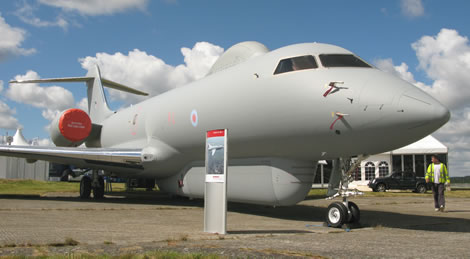The Sentinel R Mk1 Airborne Stand-Off Radar System (ASTOR) was first shown at the 2006 Farnborough Airshow, just prior to the delivery of the first aircraft. Five aircraft are to be operated by RAF V squadron, providing all-weather, day/night surveillance and target acquisition capability, supporting national, theatre and tactical headquarters with near real-time surveillance and reconnaissance imagery. The £800 million program was awarded by the British MOD in 1999 to Raytheon.
The platform is based on the Bombardier Global Express business jet. The system also includes highly mobile tactical and operational ground elements, equipped wit datalink communications and workstations to download recce products directly from the airborne ASTOR, supporting operational (division) and tactical (brigade) command echelons on the battlefield.
The airborne segment of the system consists of a Dual-Mode Radar (DMR) system, a derivative of the Raytheon Advanced Synthetic Aperture Radar System (ASARS-2) airborne battlefield or ground surveillance radar operating on the Lockheed Martin U-2R/TR-1 aircraft. On-board operator workstations and comprehensive communications suite including HF, VHF/UHF radios, SHF Satellite communications and wideband datalinks, narrow-band datalinks and LINK 16 making the system fully interoperable with RAF reconnaissance systems such as the RAPTOR recce pod carried by the Tornado and the new Reaper UAV system.
In future it is expected to work together with the Watchkeeper UAV system. It is also interoperable with US Air Force JSTARS and other NATO assets. As a radar based system, ASTOR works effectively with image exploitation means, providing all-weather enhancement for image based recce as well as automatic moving target detection and tracking in near-real time. According to Raytheon, the developer of the system, the dual-band radar detects and tracks moving targets both large and small, and discerns errant behavior by patterns of life analysis. As with similar SAR systems, all processing is done on board, providing operators on board and on the ground with image-quality view of the target, obtained under all weather and visibility conditions. High resolution SAR is used to identify targets of interest and for mapping and preparation of the battlefield.





















